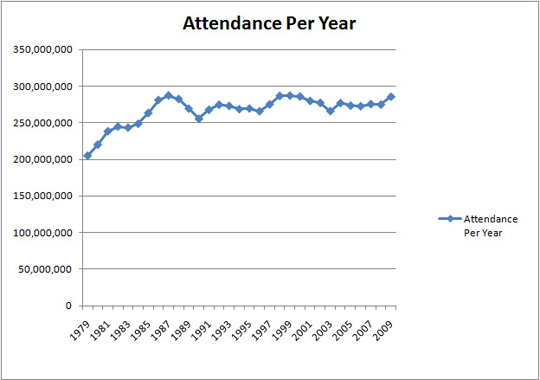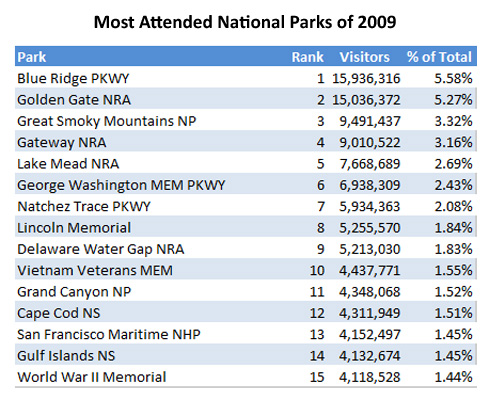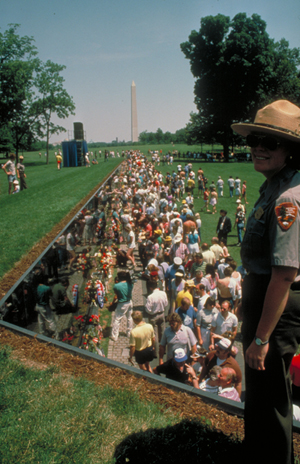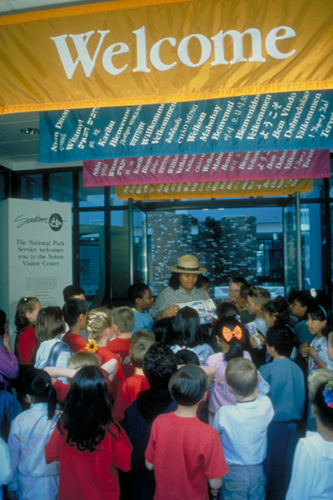
Parks balance overcrowding, preservation
The U.S. National Park Service and its 392 different locations have hosted almost record numbers of visitors in recent years.
In response, many of the parks have created plans to handle the large crowds.
In 2009, about 285 million people visited one of the various parks, which is the highest number since 1999 when just over 287 million people visited.
| Click on the video at the right to see an audio slide show about national parks visitation patterns prepared by writer Tim Capasso. |
This number has made it harder for the National Park Service to accomplish its mission.
“We are always working to balance the need for visitors to see their parks, and to preserve them for future generations,” said David Barna, chief of Public Affairs for the National Park Service. “That’s our mission and our biggest challenge.”
Barna explained that this large number of visitors seems to be climbing up in recent years after leveling off for the past eight years following the events of Sept. 11, 2001.
It is believed that the apparent leveling off of attendance figures was due to many factors including the growth of social and electronic media as entertainment venues, Americans taking long weekend trips instead of traditional week-long vacations, and a general decrease in society’s interest in nature.
 |
The graph shows varying attendance for the park each year, with a jump in park visitors in 2009 (Statistics provided by the National Park Service). |
Of the 17 different classifications of parks, the most attended types in 2009 were national parks, national recreation areas, and national memorials.
The two most visited parks last year were Blue Ridge Parkway in North Carolina and Virginia and the Golden Gate National Recreation Area in California with each hosting more than 15 million visitors.
The parks host their highest number of visitors in the summer with an average of 1.32 and 1.19 million visits per day in July and August 2009, respectively. December had the lowest visitation rates with an average of 383 thousand visitors per day while February was next lowest with 424 thousand visitors per day.
As visitation rates continue to climb, some locations have had to impose ticket limits to control access.
| Park attendance in ascending order of the 15 most visited national parks (Statistics provided by the National Park Service). |  |
The Washington Monument, the White House (part of the President’s Park), and the St. Louis Gateway Arch at the Jefferson National Expansion Memorial each currently distribute limited amounts of tickets each day.
Other parks have not had problems with the number of visitors, but rather the number of cars.
“We don’t have too many people, but we certainly have too many cars,” explained Barna.
Great Falls Park in Virginia has a limit on the number of cars that can park so they are often forced to turn many visitors away.
To alleviate some parking problems, a few national parks have created shuttle services to nearby towns and parking lots.
Zion National Park in southern Utah started its electric bus service in 2000 in an effort to eliminate traffic and parking problems while also protecting vegetation and restoring tranquility to the park.
 |
The Vietnam War Museum is host to a large number of visitors each year (Photo courtesy of the National Park Service). |
Harpers Ferry National Historical Park, Denali National Park, Acadia National Park and the National Mall in Washington have each created shuttle services also.
The Grand Canyon National Park recently began phase two of its South Rim Visitor Transportation Plan. The plan’s construction began in 2009 with phase one.
“We are experiencing traffic congestion and some resource impacts near the roads at popular viewpoints such as Mather Point due to the large volume of vehicles coming to the park each year,” said Shannan Marcak, public affairs specialist at the Grand Canyon. “The South Rim Visitor Transportation Plan was developed to help address those traffic flow and resource issues.”
Improvements from the plan have included the creation of three new visitor parking lots, a shuttle bus parking lot, and a bus staging area that will accommodate all of the park’s transit routes. New restrooms, three new picnic areas, and the re-vegetation of areas that need to be restored are also a part of the plan.
| Visitors are given a warm welcome at the park (Photo courtesy of the National Park Service). |  |
Although the current plan does not involve the creation of a rail system at the Grand Canyon, the NPS’s Barna revealed a possible plan for the future.
“We would like to build a light rail system at the Grand Canyon,” he said.
Gateway National Recreation Area in New York and New Jersey, part of the National Parks of New York Harbor, is another highly visited park in 2009. Managers there are addressing many issues involving visitation with revision of the park’s General Management Plan.
“This plan is our roadmap to the future and we are currently in the gathering information phase of the plan,” explained Jane Ahern, public affairs officer for Gateway National Recreation Area.
Gateway is currently holding open houses to get visitor input for its General Management Plan. They see it as a way to get its visitors more involved with the national park experience while also fixing some of the parks visitation problems.
Many parks around the country have taken different measures to handle the increased visitation in recent years, but it appears that limiting the number of visitors is not an option.

Comments are Closed